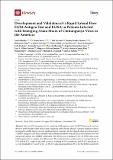| dc.contributor.author | Reddy, Ankita | |
| dc.contributor.author | Bosch, Irene | |
| dc.contributor.author | Salcedo, Nol | |
| dc.contributor.author | Herrera, Bobby Brooke | |
| dc.contributor.author | de Puig Guixe, Helena | |
| dc.contributor.author | Narváez, Carlos F. | |
| dc.contributor.author | Caicedo-Borrero, Diana María | |
| dc.contributor.author | Lorenzana, Ivette | |
| dc.contributor.author | Parham, Leda | |
| dc.contributor.author | García, Kimberly | |
| dc.contributor.author | Mercado, Marcela | |
| dc.contributor.author | Turca, Angélica María Rico | |
| dc.contributor.author | Villar-Centeno, Luis A. | |
| dc.contributor.author | Gélvez-Ramírez, Margarita | |
| dc.contributor.author | Ríos, Natalia Andrea Gómez | |
| dc.contributor.author | Hiley, Megan Jeanne | |
| dc.contributor.author | Garcia Blanco, Dawlyn J | |
| dc.contributor.author | Diamond, Michael S. | |
| dc.contributor.author | Gehrke, Lee | |
| dc.date.accessioned | 2020-09-28T14:38:13Z | |
| dc.date.available | 2020-09-28T14:38:13Z | |
| dc.date.issued | 2020-09 | |
| dc.date.submitted | 2020-07 | |
| dc.identifier.issn | 1999-4915 | |
| dc.identifier.uri | https://hdl.handle.net/1721.1/127759 | |
| dc.description.abstract | Since its 2013 emergence in the Americas, Chikungunya virus (CHIKV) has posed a serious threat to public health. Early and accurate diagnosis of the disease, though currently lacking in clinics, is integral to enable timely care and epidemiological response. We developed a dual detection system: a CHIKV antigen E1/E2-based enzyme-linked immunosorbent assay (ELISA) and a lateral flow test using high-affinity anti-CHIKV antibodies. The ELISA was validated with 100 PCR-tested acute Chikungunya fever samples from Honduras. The assay had an overall sensitivity and specificity of 51% and 96.67%, respectively, with accuracy reaching 95.45% sensitivity and 92.03% specificity at a cycle threshold (Ct) cutoff of 22. As the Ct value decreased from 35 to 22, the ELISA sensitivity increased. We then developed and validated two lateral flow tests using independent antibody pairs. The sensitivity and specificity reached 100% for both lateral flow tests using 39 samples from Colombia and Honduras at Ct cutoffs of 20 and 27, respectively. For both lateral flow tests, sensitivity decreased as the Ct increased after 27. Because CHIKV E1/E2 are exposed in the virion surfaces in serum during the acute infection phase, these sensitive and specific assays demonstrate opportunities for early detection of this emerging human pathogen. | en_US |
| dc.description.sponsorship | U.S. Public Health Service (award AI100190) | en_US |
| dc.publisher | Multidisciplinary Digital Publishing Institute | en_US |
| dc.relation.isversionof | 10.3390/v12090971 | en_US |
| dc.rights | Creative Commons Attribution | en_US |
| dc.rights.uri | https://creativecommons.org/licenses/by/4.0/ | en_US |
| dc.source | Multidisciplinary Digital Publishing Institute | en_US |
| dc.title | Development and validation of a rapid lateral flow E1/E2-antigen test and ELISA in patients infected with emerging Asian strain of Chikungunya virus in the Americas | en_US |
| dc.type | Article | en_US |
| dc.identifier.citation | Reddy, Ankita et al. "Development and validation of a rapid lateral flow E1/E2-antigen test and ELISA in patients infected with emerging Asian strain of Chikungunya virus in the Americas." Viruses 12, 9 (September 2020): 971 ©2020 Author(s) | en_US |
| dc.contributor.department | Massachusetts Institute of Technology. Institute for Medical Engineering & Science | en_US |
| dc.relation.journal | Viruses | en_US |
| dc.eprint.version | Final published version | en_US |
| dc.type.uri | http://purl.org/eprint/type/JournalArticle | en_US |
| eprint.status | http://purl.org/eprint/status/PeerReviewed | en_US |
| dc.date.updated | 2020-09-07T22:00:26Z | |
| dspace.date.submission | 2020-09-07T22:00:26Z | |
| mit.journal.volume | 12 | en_US |
| mit.journal.issue | 9 | en_US |
| mit.license | PUBLISHER_CC | |
| mit.metadata.status | Complete | |
